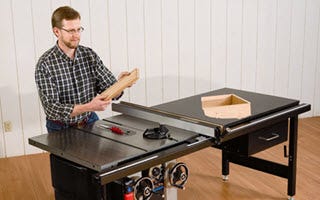A rabbet joint is a type of woodworking joinery that provides an edge to edge connection between two pieces of material. To cut a rabbet joint with a table saw, start by setting the blade height and the fence distance. For the blade height, adjust it until it’s just above the thickness of your workpiece or slightly higher.
The distance between the fence and blade should be equal to how deep you want your rabbet to be. Secure your workpieces onto the saw table using clamps or other methods, then make sure they are firmly in place before sliding them over towards the spinning blade. Make one pass through with both sides facing up so that cutting away from you at all times for safety purposes.
When done correctly, this process will produce smooth edges on both sides and create a strong joining point for two pieces together when properly glued together with wood glue..
- Step 1: Prepare the Materials – Gather the pieces of wood that will be used for the rabbet joint and make sure they are lined up correctly
- Place them on a flat surface or workbench
- Step 2: Measure the Rabbet Depth – Use a measuring tape to measure how deep you want your rabbet cut
- Make sure to use an accurate measurement as this will determine how strong your joint is when it’s finished
- Step 3: Set Up Your Table Saw – Place your table saw so that it is parallel with the edge of one piece of wood and adjust its height so that you can set the blade depth according to your measurements in Step 2
- Securely lock down any knobs or screws necessary to keep the setting in place
- Step 4: Cut One Side of The Joint – Turn on your table saw and slowly lower it into one side of each piece of wood, making sure not to press too hard as this may cause splintering or other damage to occur during cutting
- After one side has been cut, turn off your machine and remove any debris from around it before moving onto step 5
- Step 5: Flip The Wood And Repeat – Flip both pieces over carefully and repeat steps 3-4 until all four sides have been cut out, creating a perfect rabbet joint in between them!

Credit: www.rockler.com
Can You Cut a Rabbet With a Table Saw?
Yes, you can cut a rabbet with a table saw. To do this, you’ll need to make sure your saw is equipped with the right blade and fence. The best type of blade for cutting rabbets is typically a stacked dado set, which features two blades with chippers in between them.
You’ll also want to use an adjustable rip fence so that you can position it precisely where the rabbet should be cut. Once everything is set up correctly, slowly feed the material into the spinning blade as straight as possible until your desired depth and width are achieved. With some practice and patience, cutting accurate Rabbets on a Table Saw should become simple enough!
What is the Best Tool for Cutting Rabbets?
The best tool for cutting rabbets is a router. Routers are versatile tools that allow you to make precise cuts in materials such as wood, metal, and plastic. They come with different bits which can be used for various tasks including routing grooves, dadoes and rabbets.
When using a router to cut rabbit joints, it’s important to use the appropriate bit size according to your material thickness and the desired depth of the joint. Additionally, routers offer excellent control when making these types of cuts due to their adjustable speed settings which allow you to set the perfect RPMs for each job. With its precision and versatility, a router is definitely the best tool for cutting rabbets!
What Head Can Be Used to Cut Rabbets on the Table Saw?
A rabbeting head is the most common type of tool used to cut rabbets on a table saw. The head attaches directly to the arbor and is designed with two blades, each set at a different angle. The first blade cuts down into the material and creates a shoulder for the second blade to follow up along, creating an interlocking joint known as a rabbet.
This type of joinery is commonly used in woodworking projects such as boxes, frames, cabinets, and drawers. It provides great strength while maintaining smooth edges that are easy to assemble without glue or other fasteners. Additionally, this type of joinery makes it easier to customize your project since you can change either the depth or width of the rabbet simply by adjusting either one of its blades.
How Deep Should a Rabbet Cut Be?
A rabbet cut should be deep enough to accommodate the material you are joining. Generally, the depth of a rabbet cut will depend on the thickness of the material you’re using. For most standard lumber and plywood, a rabbet cut should be at least 1/4 inch deep; for thicker materials such as 2x4s or 4×8 sheets, it can be up to 1-inch deep.
It is important that your rabbet cuts match in size and shape in order to ensure an even joint when two pieces are joined together.
Cutting Rabbets on a Table Saw
Rabbet on Table Saw Without Dado
Using a table saw to create rabbets is possible without using a dado set. To accomplish this, you simply need to adjust the blade height and make multiple passes along the length of your material until you have achieved your desired depth. It’s important to remember that when making multiple passes, it’s important to move slowly so as not to cause kickback or damage your material.
If done correctly, this method can be an effective way of creating rabbets on a table saw in lieu of using a dado set.
How to Cut a Rabbet Joint by Hand
Rabbet joints are a strong and reliable joint for woodworking projects. To cut a rabbet joint by hand, you’ll need a sharp chisel or shoulder plane, as well as a marking knife and mallet. Begin by measuring the length of the rabbet that needs to be created and mark it on your work piece with a square.
Using either the chisel or plane, start cutting along one edge of the marked line until you reach your desired depth; then angle your tool toward the other side of the line to complete your cut. Finally, use sandpaper to smooth out any rough edges before assembling your project!
When Assembling a Rabbet Joint, What Can You Do to Increase Its Strength?
When assembling a rabbet joint, there are several steps you can take to increase its strength. Applying wood glue to the mating surfaces helps fill any gaps and strengthens the bond between pieces. For added strength, reinforce the joint with screws or dowels.
Additionally, if possible, use biscuits or pocket screws for extra reinforcement. Finally, make sure that your cuts are precise; even small inaccuracies in cutting can weaken the entire rabbet joint assembly.
How to Cut a Rabbet Joint With a Circular Saw
A rabbet joint is a simple yet effective way to join two pieces of wood together. To cut a rabbet joint with a circular saw, first set the saw blade depth and width according to the size of your project. Then, make sure that the saw is firmly secured in place before making any cuts.
Mark out where you want to cut and then carefully guide your circular saw along this line while ensuring that it remains level at all times. After cutting each side of the rabbet joint, use sandpaper or chisels to clean up any rough edges for a perfect finish every time!
Conclusion
This blog post provided a step-by-step guide on how to cut a rabbet joint with a table saw. It is important to use the correct safety equipment and follow all instructions carefully when using power tools such as the table saw in order to ensure safe operation. With some practice, cutting a rabbet joint with a table saw can be accomplished easily, providing an excellent way for woodworkers of any skill level to create strong joints quickly and accurately.
Table of Contents

